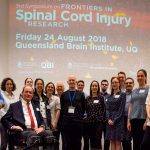University of Minnesota researchers are aiming to treat 100 volunteers with epidural stimulators in their E-STAND clinical trial. They recently published early results of the first two patients. And it’s good news for everyone with a spinal cord injury (SCI)…
Category: Research (page 10)
In UCLA study, magnetic stimulation of lower spine eliminates need for catheter for up to 4 weeks
In a study of five men whose injuries occurred five to 13 years ago, UCLA neuroscientists stimulated the lower spinal cord through the skin with a magnetic device placed at the lumbar spine. The research is the first to show…
An update from the frontier of spinal cord injury research
The 3rd SpinalCure Australia Symposium on Frontiers in SCI Research was held 24 August 2018 at the Queensland Brain Institute. SCA believes strongly that uniting scientific minds to share research outcomes and progress can help accelerate the path to the…
3D-printed nerve stem cells could help repair damaged spinal cord
Researchers at the University of Minnesota have designed a device that could reconnect the damaged spinal cord. A silicone guide, covered in 3D- printed neuronal stem cells, can be implanted into the injury site, where it grows new connections between…
Human stem cells may provide new scalable source of replacement cells for spinal cord injury
Researchers from the University of California San Diego School of Medicine have successfully created spinal cord neural stems (NSCs) from puripotent stem cells (hPSCs) that differentiate into a diverse population of cells capable of dispering throighout the spinal cord and…
Paralyzed mice with spinal cord injury made to walk again
Most people with spinal cord injury are paralyzed from the injury site down, even when the cord isn’t completely severed. Why don’t the spared portions of the spinal cord keep working? Researchers now provide insight into why these nerve pathways…
Natural compounds sourced from Australian plant could aid in the repair of injured spinal cord
Natural compounds sourced from Australian dessert plants could help stimulate cells and aid in the repair of spinal cord injuries. Researchers from Griffith University are studying how these compounds can be incorporated into the cell transplantation process to improve recovery after…
Mind rehabilitaton may help in recovery after spinal cord injury
A study from Heriot-Watt University has uncovered that the mind plays a pivotal role in rehabilitation after spinal cord injury. The Edinburgh researchers said a change in the way people view their surroundings after injury can make it harder to carry out…
Inflammation discovery opens window to better rehabilitation possibilities
Researchers from the University of Alberta have discovered that creating a mild inflammatory response improved a rat’s ability to relearn how to pick up pellets months after a spinal cord injury. “Time is of the essence,” explained lead researcher Karim…
Gene therapy restores hand function in rats
Researchers based in King’s College London have found that gene therapy can restore hand function after spinal cord injury in rats. After suffering a spinal cord injury, dense scar tissue usually forms. It is this tissue that prevents connections being…

